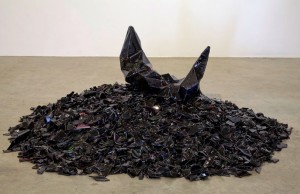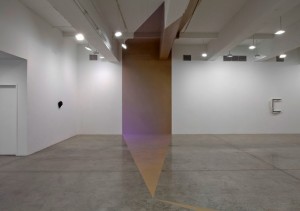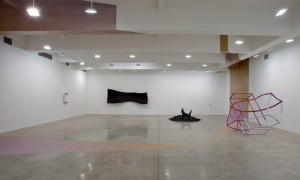Liz Larner at Bonakdar Gallery
In one sense, Liz Larner’s new installation is held together oxymoronically, by lacunae. The spaces between are a large part of the power of this impressively laconic exhibition. Moreover, the items on display not only bear their paucity proudly but are each idiosyncratic, different from the next object, except for a shared allegiance to abstraction. So how does it become so happily coherent, this display of diffidence?
To begin with, Larner has the equivalent of perfect pitch when it comes to placement and scale. Next, she does a kind of parsing of possibilities: works on the wall, on the floor; sculpture in two dimensions and three, in relief, fully rounded; a painting in tempera on a square of paper, patterns in vinyl stuck directly on floor, wall and ceiling. Forms are piled up or hung, open or closed. Things are really big, pretty big, easel size. Objects are discrete yet the room is bridged by the vinyl pattern, apparently a “tree,” but so stylized as to be entirely non-representational. The “product” is materially diverse—ceramic, rubber, tissue paper, epoxy, steel—but chromatically narrow.
One could judge this installation simply a triumph of good design, which it certainly is. Along with this, however, is an up-to-the-minute “code-mixing” expertise holding hands with a lofty commitment to old-fashioned formalism. There is even the sly joke or two here, as when the most ambitious work shown—maybe even the centerpiece since the eye is drawn to it first by virtue of its size and placement—turns out to be made of tissue paper. In its reticence, the show seems to take big risks; in its savvy virtuosity it seems like no risk at all.
Ephraim Birnbaum








